
Konya is a major city in central Turkey, on the southwestern edge of the Central Anatolian Plateau, and is the capital of Konya Province. During antiquity and into Seljuk times it was known as Iconium. In 19th-century accounts of the city in English its name is usually spelt Konia or Koniah. In the late medieval period, Konya was the capital of the Seljuk Turks' Sultanate of Rum, from where they ruled over Anatolia.
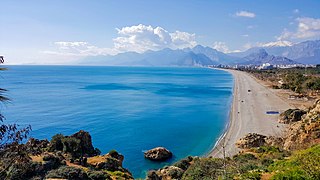
Antalya is the fifth-most populous city in Turkey and the capital of Antalya Province. Recognized as the "capital of tourism" in Turkey and a pivotal part of the Turkish Riviera, Antalya sits on Anatolia's southwest coast, flanked by the Taurus Mountains. With over 2.6 million people in its metropolitan area, it is the largest city in Turkey's Mediterranean Region, situated along the Mediterranean Sea.

The Karamanids, also known as the Emirate of Karaman and Beylik of Karaman, was one of the Anatolian beyliks, centered in South-Central Anatolia around the present-day Karaman Province. From the mid 14th century until its fall in 1487, the Karamanid dynasty was one of the most powerful beyliks in Anatolia.

Karaman, historically known as Laranda, is a city in south central Turkey, located in Central Anatolia, north of the Taurus Mountains, about 100 km (62 mi) south of Konya. It is the seat of Karaman Province and Karaman District. Its population is 175,390 (2022). The town lies at an average elevation of 1,039 m (3,409 ft). The Karaman Museum is one of the major sights.

The Sultanate of Rûm was a culturally Turco-Persian Sunni Muslim state, established over conquered Byzantine territories and peoples (Rûm) of Anatolia by the Seljuk Turks following their entry into Anatolia after the Battle of Manzikert (1071). The name Rûm was a synonym for the medieval Eastern Roman Empire and its peoples, as it remains in modern Turkish. The name is derived from the Aramaic (rhπmÈ) and Parthian (frwm) names for ancient Rome, via the Greek Ῥωμαῖοι (Romaioi).

Denizli is a city in Aegean Turkey, and seat of the province of Denizli. The city forms the urban part of the districts Merkezefendi and Pamukkale, with a population of 651,200 in 2022.

Anatolian beyliks were small principalities in Anatolia governed by beys, the first of which were founded at the end of the 11th century. A second and more extensive period of establishment took place as a result of the decline of the Seljuq Sultanate of Rûm in the latter half of the 13th century.

Isparta is a city in western Turkey. It is the seat of Isparta Province and Isparta District. Its population is 247,580 (2022). Its elevation is 1035 m. It is known as the "City of Roses".

Tokat is a city of Turkey in the mid-Black Sea region of Anatolia. It is the seat of Tokat Province and Tokat District. Its population is 163,405 (2022). It is located at the confluence of the Tokat River with the Yeşilırmak.
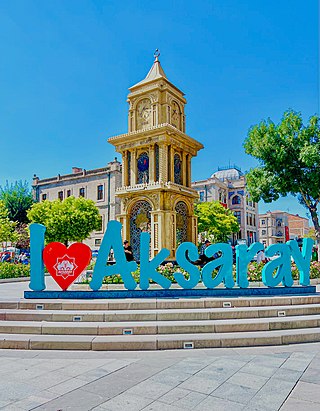
Aksaray is a city in the Central Anatolia region of Turkey. It is the seat of Aksaray Province and Aksaray District. Its population is 247,147 (2021). In 2021 the province had an estimated population of 429,069 distributed over about 7,659 km2 (2,957 sq mi). The average elevation is 980 m (3,215 ft), with the highest point being Mt. Hasan at 3,268 m (10,722 ft).

The Germiyanids was a prominent Anatolian beylik established by the Oghuz Turkish tribes after the decline of Sultanate of Rûm. However, while the beylik was always mentioned as Turkoman or Oghuz Turkish, the population consisted of Turks and Yezidi Kurds, brought by the Seljuks from the east of Malatya to western Anatolia as militia guards against the threatening Turkish tribesmen.
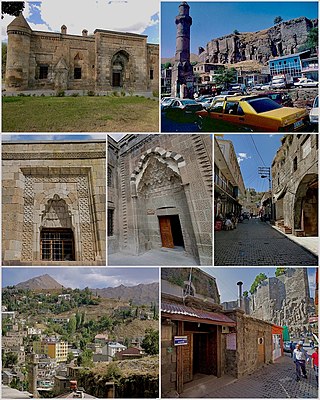
Bitlis is a city in southeastern Turkey. It is the seat of Bitlis District and Bitlis Province. Its population is 53,023 (2021). The city is located at an elevation of 1,545 metres, 15 km from Lake Van, in the steep-sided valley of the Bitlis River, a tributary of the Tigris. The local economy is mainly based on agricultural products which include fruits, grain and tobacco. Industry is fairly limited, and deals mainly with leatherworking, manufacture of tobacco products as well as weaving and dyeing of coarse cloth. Bitlis is connected to other urban centres by road, including Tatvan on Lake Van, 25 km to the northeast, and the cities of Muş (Mush), 100 km northwest, and Diyarbakır, 200 km to the west. The climate of Bitlis can be harsh, with long winters and heavy snowfalls. Since the local elections of March 2019, the Mayor of Bitlis is Nesrullah Tanğlay.

Kütahya is a city in western Turkey which lies on the Porsuk River, at 969 metres above sea level. It is the seat of Kütahya Province and Kütahya District. Its population is 263,863 (2022). The region of Kütahya has large areas of gentle slopes with agricultural land culminating in high mountain ridges to the north and west.

Niğde is a city and the capital of in the Central Anatolia region of Turkey. It is the seat of Niğde Province and Niğde District. Its population is 170,511 (2022). It lies at an elevation of 1,276 m (4,186 ft).

Nevşehir is a city in the Central Anatolia Region of Turkey. It is the seat of Nevşehir Province and Nevşehir District. Its population is 123,882 (2022). It is 290 km (180 mi) from the capital Ankara and lies within the historical region of Cappadocia.
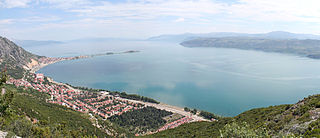
Eğirdir is a town in Isparta Province in the Mediterranean Region of Turkey. It is the seat of Eğirdir District. Its population is 16,759 (2022).

The Mediterranean Region is a geographical region of Turkey. The largest city in the region is Antalya. Other big cities are Adana, Mersin, Isparta, Antakya and Kahramanmaraş.

Hamidids or Hamed Dynasty also known as the Beylik of Hamid, was one of the 14th century Anatolian beyliks that emerged as a consequence of the decline of the Sultanate of Rum and ruled in the regions around Eğirdir and Isparta in southwestern Anatolia.
Felek al-Din Dündar Beg was Beg of Hamid from c. 1300 until his death. Felek al-Din changed his headquarters from Uluborlu to Eğirdir, which he renamed to Felekabad after himself. Although Dündar occasionally declared his loyalty to the Ilkhanate, he expanded his territory in times of internal struggles in the east. He captured Antalya and appointed his brother Yunus as its ruler, forming the Teke branch of the Hamidids. Emboldened by his victories, Dündar declared himself a sultan and minted coins without the mention of an overlord. On the other hand, the Ilkhanid governor of Anatolia, Timurtash led an extensive campaign to restore the Ilkhanid authority over the Turkmen rulers in the western frontier of Anatolia, such as Dündar. Upon the siege of Felekabad, Dündar sought protection under his nephew Mahmud in Antalya. Mahmud did not resist Timurtash and surrendered his uncle to him. Dündar was executed by Timurtash and would be succeeded by his son Khidr Beg.
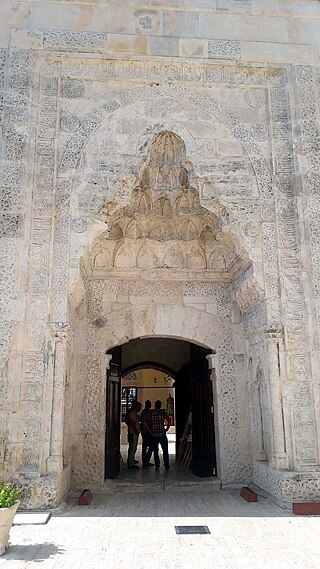
Dündar Bey Madrasa, also called Taş Medrese, is a historical madrasa in Eğirdir, Turkey. Madrasa is a medieval Islamic educational institution. In the 1960s, it was restored, and is now used as a bazaar.





















